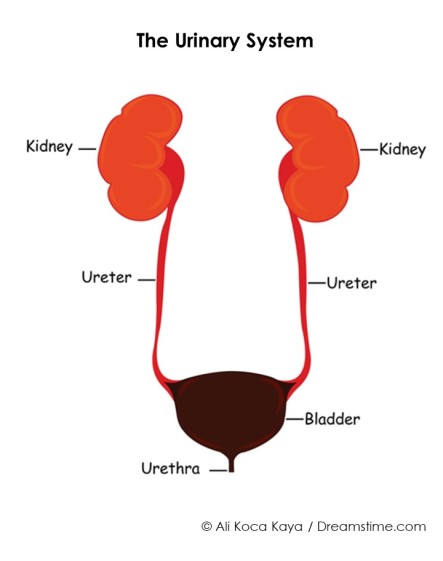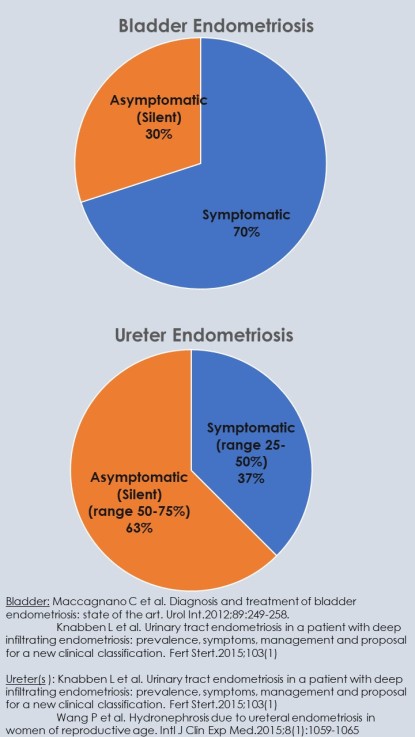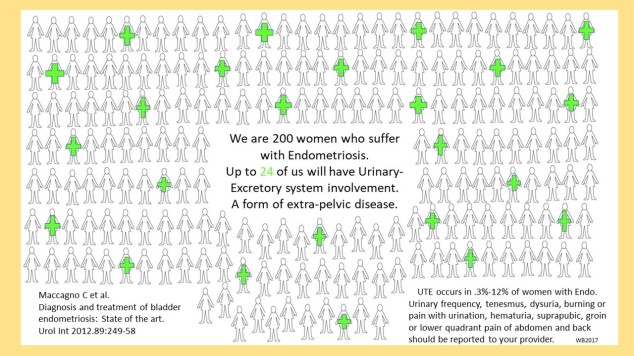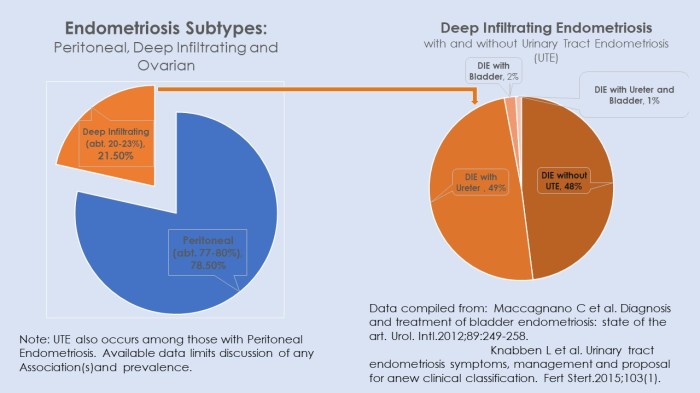It is estimated that the urinary system is the second most common location of extrapelvic endometriosis, behind digestive disease. This is based upon identified cases but is important to note, a large portion of those with urinary disease are asymptomatic by location and tissue involved. The prevalence if disease is assumed to be under representation of true rates.
The Urinary System is comprised of the ureters and, bladder and urethra. The kidney is an organ of the Excretory System but included here.

Endometriosis of the Urinary System presents its own set of concerns. If the disease is not treated early it may lead to issues of retention, incontinence and kidney damage. Unfortunately, the nature of the disease, oft silent, coupled with a lack of protocols to screen and complete advanced imaging for detailed visualization of the urinary system among women with high risk needs, poor awareness about the disease across the healthcare spectrum are additive to delayed diagnosis. Far too many persons have developed irreversible damage as a result.
“Endometriosis of the urinary tract poses a difficult problem for urologists as until recently is has been infrequently diagnosed and in all probability overlooked” -Mete Cek (2006) (1)
Patient Perspective:
“I didn’t have any symptoms, I was in hospital for a week with sepsis and they didn’t know why, so they did an ultrasound that showed my kidney wasn’t draining then I had a CT Scan that confirmed endometriosis. They used my case for training urology doctors”. – Sue (2018)
The innervation of the digestive, urinary and reproductive systems overlap and is more vague in regards to ability to determine specific location and tissue layers involved. This further complicates the ability to isolate the location(s) and source(s). Specific to endometriosis, it is common for symptoms to occur within any of these three systems regardless if lesions are not located directly on the organs of any/all of these areas.
To further complicate the issue, 30% of all bladder (2,3) and 50-75% (2,4) of all ureter disease is asymptomatic. These aspects reiterate the urgency for improved diagnosis and intervention.

The fact a significant portion of urinary tract endometriosis is asymptomatic, limited large scale prevalence studies with recorded cases that were symptomatic, discovered secondary to another condition or with direct observation during surgery, leads to a range of .3% – 12% among those with endometriosis (5-9) with tertiary care centers which receive referral and greater caseloads of complex, advanced disease report rates of 14.2% (10) and 19.5%. (11)

“The prevalence of endometriosis in specific categories of patients has been reported, but the prevalence in the general population is not definitively known because a majority of patients are asymptomatic” – Aliasghar Y and Mogharabian N (2012) (12).
Unless the urinary tract is suspected, based upon patient history and clinical assessment, the possibility of disease being missed is high. Routinely, laparoscopic surgeons access the area behind the uterus and cervix, and deep into the Pouch of Douglas. However, the entire length of the ureters cannot be routinely examined. Observation of the full ureter length requires further dissection and exploration. As the ureters transfer urine from the kidney for storage in the bladder, the final 1/3 of the ureter passes along the sides of the pouch, behind a layer of tissue (peritoneum).
Unless the surgeon visualizes a ureter, which is dilated in the upper 2/3 of its length, they may be unaware of disease present in the lower 1/3. Surgeons who treat exclusive or near-exclusive cases with endometriosis, especially complex and advanced cases, oft perform retro peritoneal assessments. Access to other surgical disciplines are available to address disease of the urinary and excretory system as needed. There is discussion about the reliability and application of enhanced protocol trans vaginal ultrasound to assess the distal ureter and bladder, which is discussed in the sub menu page: Bladder Endometriosis.
The reality that Urinary Tract Endometriosis (UTE) can lead to serious, and irreversible complications, justifies urgency to improve diagnosis and early intervention.
“UTE can cause significant morbidity, such as silent kidney or progressive renal function loss. Its frequency is underestimated and data on laparoscopic management are scarce” – Gabriel B et al. (2011) (13)
So where are lesions most commonly found?
The majority of lesions affect the bladder. About 25% of the remaining locations collectively include the Ureter(s), Kidney(s) and Urethra (in descending frequency). (1,4,12) Ratios of 40:5:1 (bladder:ureter:kidney) is still seen in publications as a generalization of specific organ likelihood to have lesions. (6,9)

Who has the most probability to develop UTE?
There is increasing discussion in regards to whether all endometriosis occurs from single source and same biological process or that numerous types of the disease exist from one or more origins. At present, however, disease is presently classified according to its location and depth of lesions: Peritoneal, Ovarian and Deep Infiltrating (DIE).

Detailed examination of urinary tract endometriosis and characteristics of deep infiltrating endometriosis is explored further on the respective sub menu pages. Each page also expands in detail of statistics, symptoms, medical and surgical management:
A separate page discusses disease which has been identified among human males:
Overview of Urinary Tract Endometriosis Citations
Support and Education Group for Sufferers and Healthcare Providers
If you are a person diagnosed with/or concerned you may have disease of the Urinary/Excretory system, support someone with the disease or a healthcare provider who wants to learn more about the condition from those with the disease and/or specialists who work with a multi-specialty surgically team to treat disease of these systems, please join us at:
Extrapelvic Not Rare Endometriosis Education and Discussion Group


All Rights Reserved. © 2018 – Wendy Bingham, DPT Extrapelvic Not Rare
